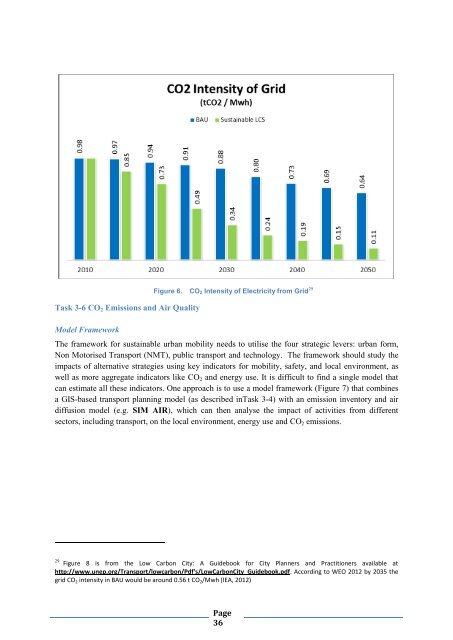Toolkits for Urban Transport Development - UNEP
Toolkits for Urban Transport Development - UNEP
Toolkits for Urban Transport Development - UNEP
Create successful ePaper yourself
Turn your PDF publications into a flip-book with our unique Google optimized e-Paper software.
Task 3-6 CO 2 Emissions and Air Quality<br />
Figure 6. CO 2 Intensity of Electricity from Grid 29<br />
Model Framework<br />
The framework <strong>for</strong> sustainable urban mobility needs to utilise the four strategic levers: urban <strong>for</strong>m,<br />
Non Motorised <strong>Transport</strong> (NMT), public transport and technology. The framework should study the<br />
impacts of alternative strategies using key indicators <strong>for</strong> mobility, safety, and local environment, as<br />
well as more aggregate indicators like CO 2 and energy use. It is difficult to find a single model that<br />
can estimate all these indicators. One approach is to use a model framework (Figure 7) that combines<br />
a GIS-based transport planning model (as described inTask 3-4) with an emission inventory and air<br />
diffusion model (e.g. SIM AIR), which can then analyse the impact of activities from different<br />
sectors, including transport, on the local environment, energy use and CO 2 emissions.<br />
29 Figure 8 is from the Low Carbon City: A Guidebook <strong>for</strong> City Planners and Practitioners available at<br />
http://www.unep.org/<strong>Transport</strong>/lowcarbon/Pdf's/LowCarbonCity_Guidebook.pdf. According to WEO 2012 by 2035 the<br />
grid CO 2 intensity in BAU would be around 0.56 t CO 2 /Mwh (IEA, 2012)<br />
Page<br />
36
















